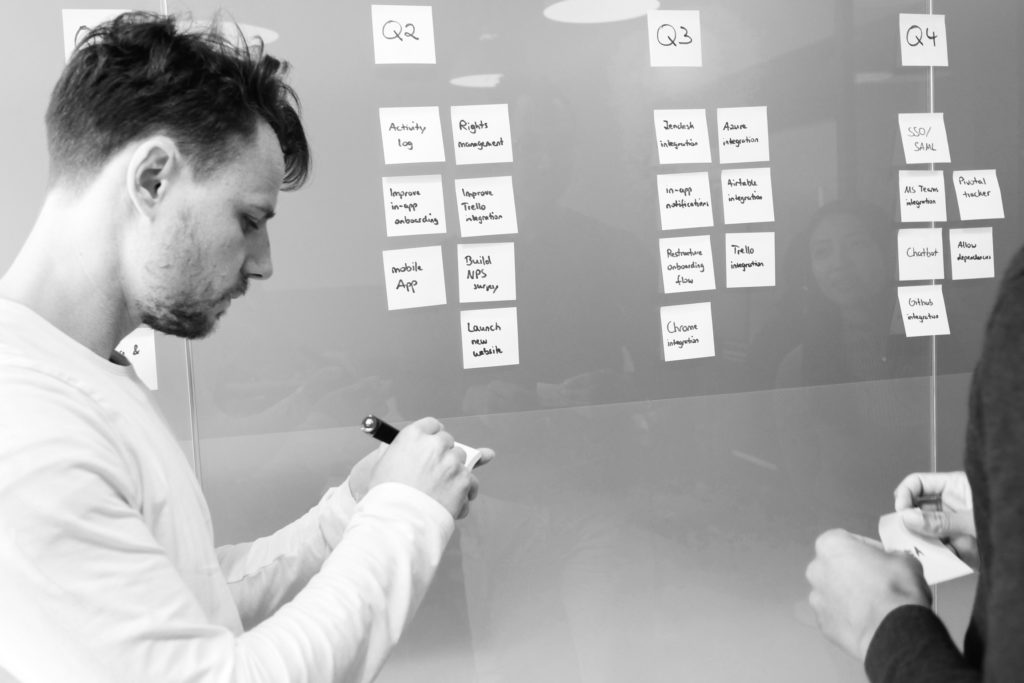Self-Organization Tools When Working Remotely

Table of Contents
Hey there, mighty Developer! Are you struggling with self-organization or looking for ways to improve your workflow? You are in the right place! Sometimes self-organization when working remotely can be one of the biggest struggles. Especially, when you are just starting out as a freelancer. In this article, we will give you tools for long- and short-term planning, talk about daily routines and task management tools, as well as the importance of fun, rest, and community.
Strategic planning
So let’s start with long-term planning. Long-term planning is asking yourself: “Where do I want to be in two, five, or 10 years?”. Yes, sometimes it seems easier to just focus on day-to-day tasks and ignore the big picture. However, without a long-term plan, you’re likely to find yourself wishing you had been more prepared down the road.
Here are a few questions you can ask yourself to plan for the future:
- Do I see freelancing as something temporary, long-term, or as my career path?
Depending on your answer, your approach and your goals will be very different.
- Do I want to use my personal name or my business name?
Though using a business name takes more effort (registering the name and other formalities) it will be useful for those who consider hiring people in the future and growing to become an agency.
- Is my specialization sustainable? Will there be a demand for my skills in the future?
Our world is always changing, so it is important to constantly learn and grow as a professional.
- How much money do I need to make to live comfortably, pay my taxes, have all of the necessary securities, and have money to reinvest in my business?
- Do I have all of the information and resources to do my taxes and all of the legal paperwork required by the government? If not, where can I find help with that?
- What health insurance, retirement plan, and financial securities should I have?
It is very important to answer these questions in advance so that you are well prepared for your future work as a freelance developer.
You might also like to learn more about working with clients and avoiding client ghosting in this

Yearly, quarterly and monthly goals
Now that we’ve settled a few important big-picture goals, let’s move on to short-term planning: yearly goals, quarterly goals, and monthly goals.
After you have decided where you want to go, it’s time to work backward and decide:
- How much do you want to earn this year as a freelance developer? Take into consideration taxes, insurance, and all of the other expenses that you’ll have.
- What clients do you want to have, what kind of projects do you want to do, what skills do you want to gain?
- How much time do you want to spend on work and what hourly rate would you like to have?
- What steps should I take this year to get closer to my long-term goals?
Write down your yearly goals, then divide them by quarter and then by month. Make sure those goals are SMART (specific, measurable, attainable, relevant, and time-bound). When you are done with that, divide goals into small steps and cross off each one as you work through them. You will be surprised how quickly you will reach your big and scary goals, as you are faithfully completing those small tasks.
Routines and time management
Now that you have set your long-term and short-term goals, it is time to talk about your day-to-day self-organization. The magic ingredient to being successful at self-organization is called ROUTINE! And yes, you will think: “ I have switched to freelancing to get away from all of the boring and mundane routines, and now you are telling me that I have to have one?!”. The good news is that you get to decide exactly what your routine will look like. Maybe it’s waking up at 12 PM and having breakfast at 1 PM. Maybe your routine will be more like a general idea of what your day should look like, without set time or deadlines.
The biggest benefit of a routine is that you don’t have to waste time every day thinking: “What should I do next?”. It is also a great procrastination buster. With a routine, you won’t have the feeling that you have all the time in the world. A great idea is to break your workday into blocks and put fun and relaxing activities in between.
Practical advice on building your routine:
- Think about your “perfect day”. What will this day include and exclude?
- Look through your commitments and see how many hours a day you need to work to achieve your goals.
- Make sure you include rest, self-care, and fun in your daily routine. Without these you will surely head into burnout, and who needs that anyway?
- Define what must be in your day no matter what (i.e. sleep, exercise).
- Set boundaries for your friends and family. With no boundaries, it is likely you will be interrupted multiple times a day with asks and meeting invites.
- Learn what your most productive time of the day is and assign your most difficult tasks to that time.

Five free task management apps
To organize the flow of your projects and tasks you will definitely need a system. It can be a digital system, paper-based or hybrid. You decide!
Here are five free task management systems that can help you with that:
- Google Calendar
It is a time-management and scheduling calendar service developed by Google. You can schedule meetings and events and get reminders about upcoming activities, see the tasks you need to finish and when. You can also integrate numerous other apps into your calendar to make it even more functional.
- Notion
It is a note-taking and project management software that can be used by yourself or for collaboration in a team. It has an endless page dive, powerful databases and offers easy integration with other apps.
- Todoist.
This is a to-do list and task management software that allows combining tasks, projects, comments, attachments, and notifications. It has a convenient reminder function, where you can create tasks and set the level of importance and a deadline to remind yourself when to take care of it.
- Trello
It’s a web-based app made for list-making in a Kanban style. It is great for collaborative work management, as it helps to track team projects, highlight tasks underway, and show who they are assigned to. It is very intuitive and easy to use.
- Airtable
This is a platform that is best described as a spreadsheet with database functions. It is easy to navigate and can be used for planning tasks, time management, project management, etc. Great to use both individually and for a team.
Fun, rest and community
We cannot emphasize enough the importance of fun, rest, and community for a freelancer. To be a thriving freelancer you need to invest in self-care and relationships. Consider planning your days in a way that incorporates fun activities, lots of breaks, full night sleep, and time for friends, family, and like-minded people. Here are a few ideas for you:
- Try using the Pomodoro technique: 25 minutes of work, five minutes of rest. After four Pomodoros take a longer break (15-20 min). This is a great time to do something fun, like take a walk, listen to your favorite music, read your favorite book or call a friend.
- Add fun activities into your calendar and treat them as seriously as you would a call with a client.
- Make sure that you set your downtime. This is the time when you put down your work and become unavailable for calls and messages. Define this beforehand, set it as a reminder in your calendar, and let your clients know about it.
- Join a coworking space so that you can be surrounded by other freelancers and won’t feel lonely working from home all of the time
- Attend professional networking events. It might be fun and refreshing to meet new people, listen to other professionals in your field and just change the scenery once in a while.
It can be intimidating at first: being your own boss, organizing your time, projects, client communication. However, with time and practice, all of this will become your second nature. Give these ideas a try and let’s see how much better your self-organization will become.
If you are interested in trying out freelancing but without the risks and hurdles associated with that (like learning to sell yourself) consider joining our platform at Lemon.io. It is a reliable platform that connects early-stage startups with freelance developers. The platform helps developers with sales, legal work, risks, and all that. We make sure you can focus on doing your work and leave all of the rest to the platform.
Need some extra info? Here's our FAQ!
What tools do I need to work remotely?
There are a variety of tools that can be helpful when working remotely, including:
Communication and collaboration tools: Tools such as Slack, Skype, or Zoom can be used to communicate remotely and collaborate with team members and clients.
Project management tools: Tools such as Asana, Trello, or Basecamp can be used to manage and track project progress remotely.
File sharing and storage tools: Tools such as Google Drive, Dropbox, or OneDrive can store and share files with team members and clients remotely.
Time tracking and invoicing tools: Tools such as Toggl, Freshbooks, or Harvest can be used to track time spent on projects and create invoices for clients.
Virtual meeting tools: Tools such as Google Meet, GoToMeeting, or Webex can be used to hold virtual meetings with team members and clients.What technology do you need to work from home?
A reliable computer: You will need a computer with sufficient processing power and storage to handle your work tasks.
A stable internet connection: A stable and fast internet connection is essential for working from home, as you will need to connect to the internet for most tasks.
A headset: A headset with a microphone can help participate in conference calls or virtual meetings.
A webcam: A webcam can be useful for participating in virtual meetings or video calls.
A good quality monitor: A good quality monitor can help reduce eye strain and improve your overall productivity when working from home.How can I improve my remote working?
There are several steps you can take to improve your remote working:
Set up a dedicated workspace: Having a dedicated workspace can help you stay focused and reduce distractions.
Establish a routine: Developing a consistent routine can help you stay organized and productive when working from home.
Stay in communication with your team: Regular communication with your team can help ensure that you are aligned on tasks and deadlines.
Use productivity tools: There are a variety of productivity tools that can help you manage your time and stay organized when working from home.
Take breaks: It is important to take regular breaks to rest and recharge, as this can help improve your overall productivity.Which additional tools can be used to build good relationships with a remote and international workforce?
Here’s just a few tools that can miraculously change your remote business communication and make it swift & secure:
– Slack (for work groups, chats, huddles, and bots);
– Evernote/Notion (for work documentation sharing);
– Zoom (for work online meetings);
– Dropbox (for remote file access and sharing).What tool helps a user access the office while working from home?
Virtual Private Network (VPN): A VPN allows users to securely connect to their office network from a remote location, giving them access to office resources such as servers, printers, and network drives.
Remote Desktop: Remote Desktop allows users to remotely access and control their office computers from a remote location, giving them access to all of their applications and files.
Cloud-based tools: Cloud-based tools such as Google Drive or Dropbox allow users to access and share files with team members from any location.
Collaboration tools: Tools such as Slack or Microsoft Teams allow users to collaborate with team members and access shared resources such as documents and project files.
Explore our stacks and pages: Axios, Vue.js, Unit testing, Apache Tomcat, AWS









